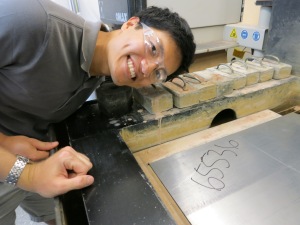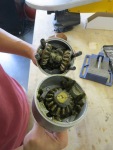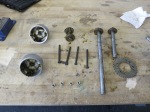So given that we’re going to use two motors driving two rear wheels, we’ve done some calculations and we’ve realized that the kv of the motors we’ve been browsing are too damn high. The problem was that with the gear ratio given and the max speed that we’d be travelling at, the motors that we’re using won’t even be able to reach half of it’s no load rpm, which meant that the motors won’t be able to reach their peak power, which is at half of the no load rpm, and won’t be efficient, which only comes after peak power. And both power and efficiency are important.
The max gear ratio (to increase motor rpm) was also largely fixed to between 3-4:1. Even if we could buy any sprocket size we wanted, the sprocket would have to be smaller than the wheel we were using, and so eventually it didn’t matter anyway (since a larger wheel would accommodate a larger sprocket but would also need more torque to drive etc.). The smallest sprocket we could find for the motor had 12 teeth, and so that limited our options on the other end. We could design a custom gearbox to change gears/have a higher gear ratio, but we decided against this extra mechanical complexity and decided to go for a single speed (so we could also use can brakes).
We’ve therefore decided to go for an outrunner with the lowest kv we could find that was still within our budget, and this was it.
Following from there, since we already intended to buy two of those, we had to choose a controller for these outrunners. We looked around on kelly controller and found a cheap controller that was apparently on sale at $59.99. We chose this controller because it could withstand a burst of 50A, and since we already intended to get a fourth battery, we could split the batteries between both motors to get a max current per motor of 80A (which we’d probably never reach anyway due to battery internal resistance etc.) Plus it came cheap, so it was perfect since we had to buy two of both the controller and the motor.
Budget check: 500-59.99*2-80.08*2-75=144.86
Woah. Depleting fast.
Since the sprocket size on the wheel didn’t really matter (it’d be the biggest the wheel would accommodate), we decided to go for small wheels so that we could have a smaller rotational inertia, and be lower to the ground (which we needed for handling issues).
After surfing about on McMaster we found a soft rubber wheel which already had a bearing for 13.18 each. Ouch. However, what attracted us was the flat surface and the apparently hard material used to make the wheel (both of which would help us when we wanted to attach the sprockets/brakes etc.).
Then followed a bunch of stuff like brake pads and ball joints and threaded rods and bronze thrust bearings etc. and we’re left with… 54.75!
And we haven’t even got to bolts and nuts and brakes and aluminium rods (for steering). Oh dear. Regardless, the BOM is here for your viewing pleasure (whoever you are):
| Description |
Name |
Vendor |
Unit Price |
Quantity |
Total |
Part ID |
| Motor Controller |
KBS36051 |
Kelly Controller |
59.99 |
2 |
119.98 |
KBS36051 |
| Motor |
Turnigy Aerodrive 6374-149kv |
HobbyKing |
80.08 |
2 |
160.16 |
6374-149kv |
| Brake Pads |
Clarks Shimano Road Brake Pads |
Jenson USA |
3.99 |
1 |
3.99 |
BR271D00 |
| Wheels |
High Performance Rubber Tread Wheels with Soft Tread and General Purpose Bearings |
McMaster-Carr |
13.18 |
4 |
52.72 |
2829T18 |
| Accelerator Pedal |
Foot Pedal Throttle Cable (Hall Effect) |
TNC Scooters |
12.5 |
1 |
12.5 |
THR-101125 |
| Ball Joint |
Ball Joint Linkage Shielded, Steel, 1/4″-28 Right-Hand Thread Size |
McMaster-Carr |
2.94 |
4 |
11.76 |
6058K25 |
| Threaded Rod |
ASTM A193 Grade B7 Alloy Steel Threaded Rod Plain Finish 1/4″-28 Thread, 3′ Length |
McMaster-Carr |
4.78 |
1 |
4.78 |
92580A107 |
| Thrust Bearing |
Graphite SAE 841 Bronze Thrust Bearing for 3/8″ Shaft Diameter, 3/4″ OD, 1/8″ Thick |
McMaster-Carr |
1.09 |
4 |
4.36 |
7447K3 |
| Battery |
A123 Systems ALM 12V7 |
A123 |
75 |
1 |
75 |
|

































